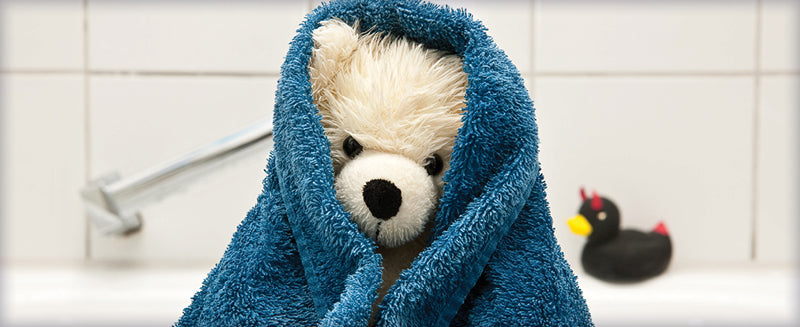

· By The Wakaii Team
Plushie Care Made Easy: Essential Tips and Practices
This guide is packed with practical tips and tricks to keep your plushies clean, cuddly, and cute for years to come. So, let's dive in!
Understanding Your Plushie
Most plushies have a care label that provides specific cleaning instructions. If your plushie's care label is missing or unreadable, don't worry!
We've got you covered with general care tips that should work for most plushies.
Regular Plushie Maintenance
Regular maintenance is key to keeping your plushies looking their best. Here are a few daily care tips to keep in mind:
- Keep Plushies Dry: Moisture can lead to mold and mildew, which can damage your plushies and even cause health problems. Always dry your plushies thoroughly after cleaning, and try to keep them away from damp areas.
- Avoid Direct Sunlight: Just like with other fabrics, prolonged exposure to direct sunlight can cause your plushies' colors to fade. Keep your plushies in a cool, shaded area to preserve their vibrant colors.
- Rotate Your Plushies: If you have a large collection of plushies, try to rotate which ones you cuddle with. This can help prevent wear and tear on your favorite plushies.
In addition to these daily care tips, it's important to clean your plushies regularly. But how often should you clean your plushies? Well, that depends on a few factors.
If you or your child sleep with a plushie every night, or if the plushie is played with often, you should aim to clean it about once a week.
If the plushie is more of a display item, cleaning it once a month should be sufficient.

Pre-Cleaning Considerations
Before you start cleaning your plushie, there are a few things you should do to prepare:
- Check for Damages: Look over your plushie for any rips, tears, or loose parts. If you find any, it's a good idea to repair them before cleaning to prevent further damage.
- Remove Accessories: If your plushie has any removable parts, like clothing or batteries, take them off before cleaning. This will make the cleaning process easier and prevent damage to these parts.
- Pre-Treat Stains: If your plush toy has any visible stains, it might be necessary to pre-treat them before the main wash. The specific process can vary depending on the type of stain and the type of fabric.

Cleaning Your Plushies
Depending on your plushie's care instructions and the type of dirt or stain, you might choose one of the following methods:
- Machine Washing: This can be a great way to clean your plushies, especially if they're made of durable materials like polyester. However, always check the care label first to ensure your plushie is machine-washable.
- Hand Washing: If your plushie isn't machine-washable, or if you prefer a more hands-on approach, hand washing is a great option. This involves gently cleaning your plushie in a basin or sink using a mild detergent.
- Spot Cleaning: For minor spills or stains, spot cleaning is a quick and easy solution. This involves applying a cleaning solution directly to the stain and gently blotting it with a clean cloth.
Each method has its own considerations and steps to follow to ensure your plushie gets clean without getting damaged.

Drying Your Plushies
Proper drying is just as important as proper cleaning when it comes to plushie care.
Depending on your plushie's care instructions and your available resources, you might choose one of the following methods:
-
Air Drying: When it comes to drying plushies, air drying is the go-to method for most.
- Tumble Drying: For some plushies, tumble drying might do the trick. However, it's essential to check the care label first, or you might end up with an unintended mini version.
- Hair Drying: If you're in a bit of a rush, hair drying is your new best friend.
Whether you're air drying, using a hair dryer, or even a tumble dryer, it's important to know the right way to do it.

Post-Cleaning Care
Once your plushie is clean and dry, there are a few more steps you can take to keep it looking its best:
- Fluff and Reshape: After washing and drying, your plushie might need a little help getting back into shape. Gently fluff the stuffing and reshape the plushie as needed.
- Check for Damages: Cleaning can sometimes reveal hidden damages. If you find any new rips or tears, repair them as soon as possible to prevent further damage.
- Store Properly: If you're not going to be using your plushie for a while, store it in a cool, dry place away from direct sunlight. Consider using a breathable fabric bag to protect it from dust.

Special Care Situations
Sometimes, you might encounter a situation that requires special care. Here are a few common ones:
- Antique or Delicate Plushies: These plushies often require extra gentle care.
- Pest Infestations: If your plushie gets infested with pests like lice or bed bugs, it's important to clean them in the right way.
- After Illness: If your child has been sick, it's a good idea to sterilize your plushies to prevent the spread of germs.
Wrapping up
That's it for our ultimate guide to plushie care! We've covered everything from understanding your plushie, regular maintenance, cleaning methods, to drying and post-cleaning care, and even special care situations.
Remember, a little bit of regular care can go a long way in ensuring your plushies' longevity.
We hope you've found this guide helpful in keeping your kawaii companions clean, cuddly, and cute for years to come.
Before you go, don't forget to check out our adorable plushies collection at Wakaii. We have a wide range of kawaii plushies that are sure to bring a smile to your face.
And if you want to stay updated on all things kawaii, subscribe to our newsletter for 15% off your next order. Happy plushie parenting!
Have any questions? Please let us know and we're happy to help!
FAQs
If the plushie is frequently used or slept with every night, aim to clean it about once a week. If the plushie is more of a display item, cleaning it once a month should be sufficient.
This depends on the plushie's care instructions. Some plushies can be machine washed, but always check the care label first.
You can air dry, use a hair dryer, or even a tumble dryer, depending on the plushie's care instructions. Always ensure the plushie is thoroughly dry to prevent mold and mildew.
After cleaning, you should fluff and reshape the plushie, check for any new damages, and store it properly in a cool, dry place away from direct sunlight.
Some plushies may have specific care instructions due to their materials or construction. Always check the care label and when in doubt, opt for the gentlest cleaning methods.

